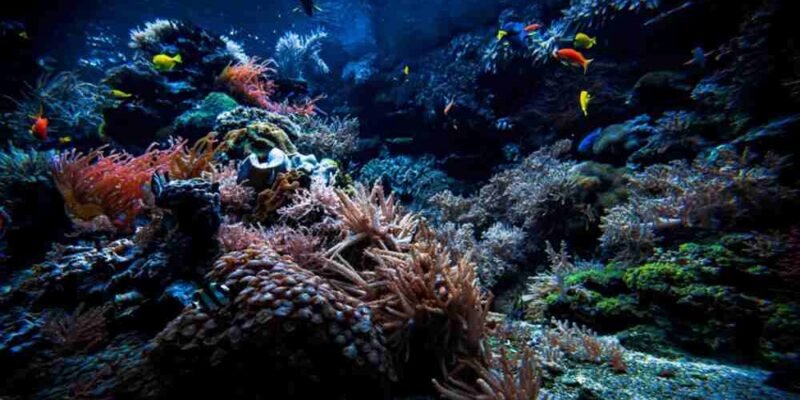Introduction
The deep sea, the vast, mysterious expanse beneath the ocean’s surface, remains one of the least explored and least understood areas on Earth. Stretching across more than 60% of our planet, the deep sea is home to some of the most remarkable and alien environments imaginable. Despite covering most of the Earth’s surface, scientists have explored less than 5% of the oceans in detail. As technology advances, however, our understanding of this enigmatic world continues to expand, revealing a treasure trove of bizarre creatures, unique ecosystems, and valuable resources.
In this blog, we will examine the fascinating facts about the unexplored ocean—an area as mysterious as it is awe-inspiring.
The Deep Sea Is a Vast and Mysterious Realm
The deep sea begins where the sunlight no longer penetrates, generally at a depth of around 200 meters (656 feet). It extends to the ocean’s floor, where depths can reach more than 11,000 meters (36,000 feet) in places like the Mariana Trench. While we typically think of the “ocean” as just a large body of water, the actual “deep sea” refers to depths beyond the reach of sunlight, where only specialized life forms can survive.
Most of the world’s oceans are considered deep sea. Unlike shallow marine environments, the deep sea is not influenced by weather or surface conditions, making it an alien world with unique characteristics. Extreme pressures, frigid temperatures, and complete darkness create an environment unlike any other on Earth.
Incredible Pressure and Cold
One of the deep sea’s most striking features is its immense pressure, which increases by one atmosphere (101 kPa) for every 10 meters of descent. At the deepest point, the Mariana Trench, the pressure is more than 1,000 times sea-level atmospheric pressure. This extreme pressure can crush human-made submarines, yet, surprisingly, many organisms thrive under these conditions.
The temperature in the deep sea is just as extreme, hovering around 4°C (39°F)—just above freezing. These conditions create a hostile environment for most life forms, but deep-sea creatures have adapted incredibly. For example, some animals, like the giant squid, have flexible bodies to withstand crushing pressure without destruction.
Bioluminescence: The Light of the Deep Sea
One of the most fascinating aspects of deep-sea life is bioluminescence—the ability of certain organisms to produce light. This ability is crucial in an environment without natural sunlight. Bioluminescence is used for various purposes, including hunting, communication, and mating.
Approximately 75% of deep-sea species are bioluminescent, including creatures like anglerfish, which use a glowing lure to attract prey, and firefly squids, which flash intricate patterns of light. These creatures produce light using specialized cells called photophores, which contain light-emitting chemicals. Some animals, like the lanternfish, use bioluminescence to camouflage themselves by blending with the faint light from above.
The Deep Sea Is Home to Some of the Oldest and Most Primitive Life Forms
While the deep sea is a place of extreme conditions, it also houses some of the oldest and most primitive life forms on Earth. Certain species, like the deep-sea sponge Monorhaphis or the giant tube worm Riftia pachyptila, have been around for millions of years and are considered living fossils.
Some deep sea areas are home to “ancient” ecosystems that have remained largely unchanged for millennia. Hydrothermal vent ecosystems, for example, support communities of life that rely on chemosynthesis (creating food from chemicals emitted from the Earth’s core) instead of sunlight. These vents are thought to resemble early Earth’s conditions, offering clues to the origins of life.
The Deep Sea Hosts Extraordinary Creatures
The deep sea is home to some of the most bizarre and otherworldly creatures ever discovered. Among the most famous deep-sea inhabitants are the giant squid and the colossal squid, which can grow up to 13 meters (43 feet) in length and weigh as much as half a ton. These elusive creatures are rarely seen. Still, their massive eyes—some of the largest in the animal kingdom—help them detect faint traces of light in the pitch-black environment.
Other fascinating deep-sea species include the anglerfish with its bioluminescent lure, the gulper eel, which can swallow prey twice its size, and the viperfish, which uses sharp fang-like teeth to capture prey. Then there’s the aptly named “ghost fish,” the Barreleye fish, with a transparent head that allows it to spot prey with enhanced vision.
Perhaps the most mysterious is the deep-sea octopus Grimpoteuthis, also known as the “dumpling octopus” or “glass octopus.” It floats gracefully through the water, and its gelatinous body makes it nearly invisible in the dark depths.
The Deep Sea Is a Vital Part of the Earth’s Carbon Cycle
The deep ocean plays a critical role in regulating the Earth’s climate, mainly through its involvement in the carbon cycle. As the world’s largest carbon sink, the deep sea absorbs large amounts of carbon dioxide (CO2) from the atmosphere. This process helps reduce the amount of CO2 in the air, which would otherwise contribute to global warming.
When plankton in the surface ocean dies, it sinks into the deep ocean, carrying carbon. The deep sea then serves as a long-term storage system for this carbon, known as the “biological pump.” The efficiency of this process is crucial for mitigating the effects of climate change, making the deep sea a key player in maintaining the global temperature balance.
Unexplored Resources in the Deep Sea
The deep sea is also thought to be a treasure trove of untapped natural resources. From rare minerals and precious metals to pharmaceutical compounds and biotechnological innovations, the ocean floor holds great promise.
For instance, deep-sea hydrothermal vents may contain valuable minerals like gold, silver, and copper. These deposits are formed by volcanic activity and could be mined. Additionally, deep-sea organisms have inspired groundbreaking advances in medicine and biotechnology. For example, an enzyme from the bacteria Thermococcus gammatolerans is crucial for PCR (Polymerase Chain Reaction) technology, which is used in genetic research.
We Know Less About the Deep Sea Than We Do About Space
It’s astounding that we know more about the surface of the Moon and Mars than about the deep sea. According to the National Oceanic and Atmospheric Administration (NOAA), about 80% of the ocean remains unexplored, and scientists continually make discoveries that challenge our understanding of marine life.
Technology like remotely operated vehicles (ROVs) and autonomous underwater vehicles (AUVs) are slowly unlocking the mysteries of the deep, but there is still so much more to uncover.
Conservation of the Deep Sea Is Urgent
The deep sea is under increasing pressure from human activity, including deep-sea mining, oil drilling, and fishing. These activities can cause irreversible damage to fragile ecosystems that have evolved over millions of years. For example, deep-sea mining destroys unique habitats and releases toxic substances into the environment.
Protecting the deep sea has become a global priority, and international organizations are working to establish marine protected areas (MPAs) to safeguard these ecosystems. The United Nations is also drafting agreements to prevent the exploitation of international waters without regard for conservation efforts.
Conclusion
The deep sea remains one of Earth’s final frontiers, teeming with life and secrets waiting to be uncovered. While we have made significant strides in understanding this mysterious world, it is clear that much remains to be discovered. As technology advances, we are only beginning to scratch the surface of the deep sea’s many mysteries. From strange creatures to ancient ecosystems and untapped resources, deep-sea research continues to reveal the importance of this awe-inspiring and essential part of our planet.
Protecting the deep sea for future generations is a responsibility we all share, ensuring its wonders continue to inspire and sustain life on Earth. Whether it’s the promise of new medicines, insights into life’s origins, or preserving the planet’s health, the deep sea holds secrets that will shape our future in ways we’ve yet to imagine.
Do Read: Best Places to Travel in the USA: Top Locations to Visit in 2024













